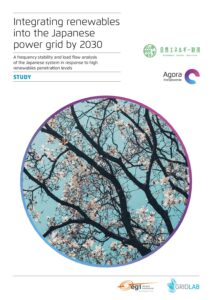The task of integrating a high level of renewables into the power mix while reducing the proportion of conventional generation such as coal and nuclear presents Japan’s power system with new challenges. Increased uptake of variable renewables, and particularly solar PV (49 GW total installed capacity at the end of 2017), has heightened concern over the impact of variable renewables (VRES) on grid stability. This has prompted investigations into various possibilities of incentivising sufficient system flexibility. Against this backdrop, grid integration studies have become an invaluable means of facilitating informed debate and guiding national policy.
This study, jointly conducted by Japan’s Renewable Energy Institute and Agora Energiewende, investigates the impact of the integration of renewables in Japan on frequency stability and – to a lesser extent – power flows. It is based on a modelling and simulating tool chain of the Japanese power system developed for this project by Elia Grid International and Gridlab, which aims to facilitate independent third-party research. The study compares two scenarios for the year 2030: the government’s target scenario, which provides for a renewables penetration level of 22–24% (64 GW solar and 10 GW wind), and a more ambitious scenario (100 GW solar and 36 GW wind). The study examines how the system responds at a number of extreme snapshots involving very high nonsynchronous renewables penetration levels (i.e. wind and solar energy). At these levels, conventional power plants are displaced, thereby pushing down the inertia limits that play a key part in ensuring the Japanese power system’s frequency stability.


